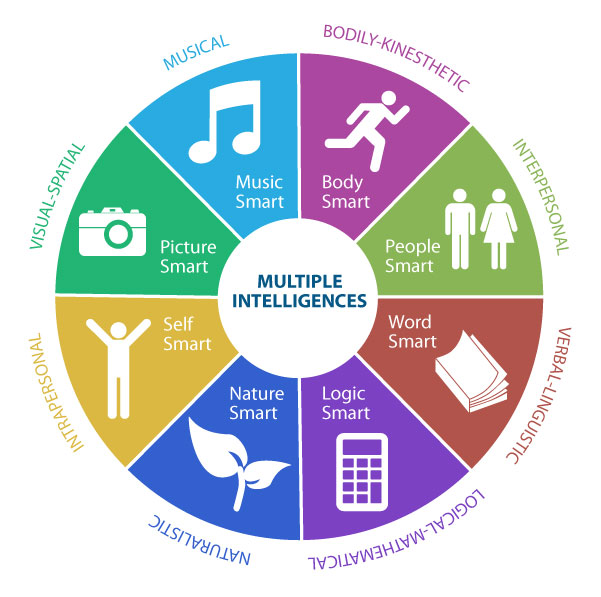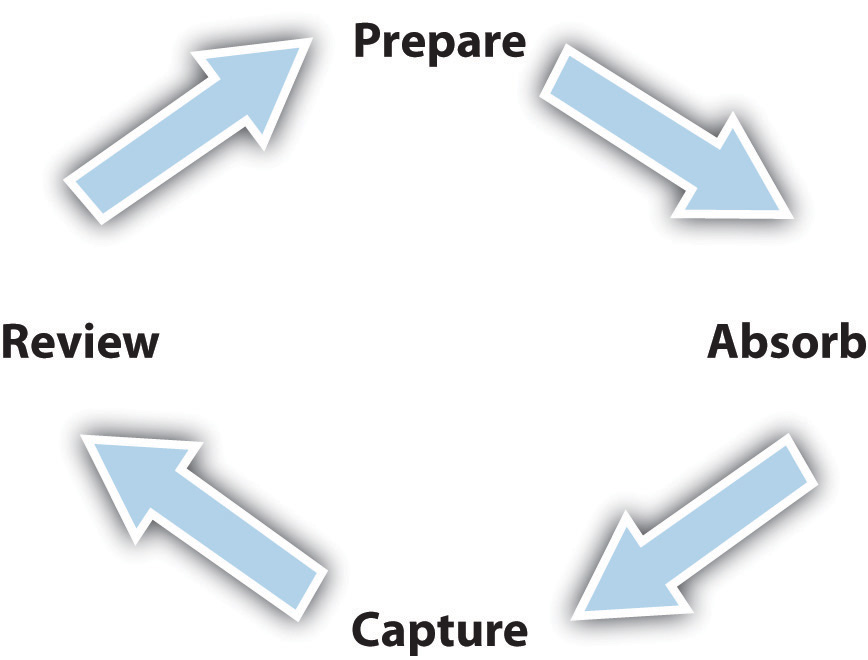Chapter 1: You and Your University Experience
1.3 How You Learn
Learning Objectives
- Understand and make effective use of the four steps of the learning process.
- Describe the different learning styles of different university students and recognize your own learning preferences.
- Know how to benefit from your own learning style and how to expand your learning skills with the techniques of other styles.
- Take action to learn effectively when your learning style differs from your instructor’s teaching style.
One of the first steps for becoming a successful student is to understand the learning process itself. Certain characteristics of effective learning, including the four-step learning cycle, are true of all people. At the same time, people have different learning styles. Understanding these processes is important for maximizing your own learning while in university.
The Learning Cycle: Four Steps to Learning
Adult learning is different from learning in primary and secondary school. In high school, teachers often take much of the responsibility for how students learn—encouraging learning with class discussions, repeating key material, creating study guides, and looking over students’ shoulders to make sure no one falls behind. In university, most of the responsibility for learning falls on the student. You’re free to fail—or succeed—as you choose. This applies as well to how well you learn.
Learning an academic subject means really understanding it, being able to think about it in meaningful ways and to apply that understanding in new situations. This is very different from simply memorizing something and repeating it back on a test. Academic learning occurs most effectively in a cycle of four steps:
- Preparing
- Absorbing
- Capturing
- Reviewing
Think first about the different situations in which you learn. Obviously you learn during class, whether by listening to the instructor speak or in class discussions in which you participate. But you also learn while reading your textbooks and other materials outside of class. You learn when you talk with an instructor during office hours. You learn by talking with other students informally in study groups. You learn when you study your class notes before an exam. All of these different learning situations involve the same four-step process.
Prepare
One student rolls out of bed a few minutes before class and dashes across campus and grabs the last seat in the hall just as the instructor begins a lecture; it takes him a few minutes to find the right notebook in his backpack, and then he can’t find a pencil. He’s thinking about how he should’ve set his alarm a little earlier so he’d have had time to grab a cup of coffee, since he’s having trouble waking up. Finally he settles in his seat and starts listening, but now he can’t figure out what the instructor is talking about. He starts jotting down phrases in his notes anyway, thinking he’ll figure it out later.
Another student looks over his notes from the previous class and quickly glances back at passages he’d highlighted in the textbook reading. He arrives at class a few minutes early, sits up front where he can hear well, and has his notebook open and pencil out. While waiting for the instructor to arrive, he talks to another student about her ideas for the paper due next week in this class.
It’s obvious which of these students will learn more during today’s class lecture. One has prepared and the other has not, and they will experience a huge difference in their understanding of today’s topic. Preparing to learn is the first step for learning. The same is true when you sit down to read your textbook, to study for an exam, or to work on an out-of-class project. Partly you are putting yourself in the right mind-set to learn. But when you review yesterday’s notes to prepare for today’s class, you are also solidifying yesterday’s learning.
Absorb
“Absorbing” refers to the actual taking in of new ideas, information, or experience. This is what happens at the moment a student listens to a class lecture or reads a textbook. In high school, this is sometimes the only learning step taken by some students. They listened to what the instructor said and “regurgitated” it back on the test. But this won’t work in university because learning now requires understanding the topic, not just repeating facts or information. In coming chapters you’ll get tips for improving in this step.
Capture
“Capturing” refers to taking notes. No matter how good your memory, you need to take good notes in university simply because there is so much to learn. Just hearing something once is seldom enough. You have to go back over the material again, sometimes several times again, thinking about it and seeing how it all fits together.
The more effective your note-taking skills, the better your learning abilities. Take notes also when reading your textbooks. You’ll learn methods for taking good notes in later chapters.
Review
The step of reviewing—your class notes, your textbook reading and notes, and any other course materials possibly including recordings, online media, podcasts, and so on—is the next step for solidifying your learning and reaching a real understanding of the topic. Reviewing is also a way to prepare for new information and ideas. That’s why this is a learning cycle: the end of the process loops back to the beginning as you prepare for additional learning.
Reviewing is also the step in which you discover whether you really understand the material. If you do not understand something fully, you may need to reread a section of the book, talk it over with a friend in the class, or go see your instructor.
What’s Your Learning Style?
Different people have different learning styles. Style refers to a student’s specific learning preferences and actions. One student may learn more effectively from listening to the instructor. Another learns more effectively from reading the textbook, while another student benefits most from charts, graphs, and images the instructor presents during a lecture.
Learning style is important in university. Each different style, described later in more detail, has certain advantages and disadvantages compared with other styles. None is “right” or “wrong.” You can learn to use your own style more effectively.
University instructors also have different teaching styles, which may or may not match up well with your learning style. Although you may personally learn best from a certain style of teaching, you cannot expect that your instructors will use exactly the style that is best for you. Therefore it is important to know how to adapt to teaching styles used in university.
Different systems have been used to describe the different ways in which people learn. Some describe the differences between how extroverts (outgoing, gregarious, social people) and introverts (quiet, private, contemplative people) learn. Some divide people into “thinkers” and “feelers.” A popular theory of different learning styles is Howard Gardner’s “multiple intelligences[1],” based on eight different types of intelligence:
- Verbal (prefers words)
- Logical (prefers math and logical problem solving)
- Visual (prefers images and spatial relationships)
- Kinesthetic (prefers body movements and doing)
- Rhythmic (prefers music, rhymes)
- Interpersonal (prefers group work)
- Intrapersonal (prefers introspection and independence)
- Naturalist (prefers nature, natural categories)

The multiple intelligences approach recognizes that different people have different ways, or combinations of ways, of relating to the world. Here is an example of visual-spatial intelligence, as an artistic, autistic savant draws the New York City skyline from memory.
Video – https://www.youtube.com/watch?v=bsJbApZ5GF0 = (length 3:49)
Another approach to learning styles is called the VARK approach [2], which focuses on learning through different senses (Visual, Aural, Reading/Writing, and Kinesthetic):
- Visual learners prefer images, charts, and the like.
- Aural learners learn better by listening.
- Reading/writing learners learn better through written language.
- Kinesthetic learners learn through doing, practicing, and acting.
You can take a free, self-scored online assessment of your VARK learning style at http://www.businessballs.com/freepdfmaterials/vak_learning_styles_questionnaire.pdf.
There are still more systems used by educators to describe the various ways in which people learn. All of these systems can help you learn more about how you as an individual person and university student learn best. You can use the online assessment in the “Outside the Book” section at the end of this chapter to learn more about your style.
Just knowing your style, however, doesn’t automatically provide a solution for how to do your best in your university courses. For example, although you may be a kinesthetic learner, you’ll likely still have textbook reading assignments (verbal learning) as well as lecture classes (listening). All students need to adapt to other ways of learning.
The following sections look at the key ways in which learning occurs in university classes and offer some suggestions about how to adapt your strengths for success.
Reading
Reading skills are critically important in university. Most classes involve reading assignments. Although many instructors may cover some of the textbook’s content in lectures or class discussions, students cannot skip the reading assignments and expect to do well.
If your personal learning style is verbal and independent—that is, if you learn well by sitting alone and reading—then you will likely not have difficulty with your university reading. Here are some tips to help maximize your learning:
- Underline and highlight key ideas when reading.
- Take good notes on your reading, using your own words.
- Write descriptions that summarize information presented in nonverbal modes, such as through charts and graphs.
- Do all optional and supplemental readings.
- Take good notes in class, as you may remember more from your written words than from the instructor’s spoken words.
- If a class involves significant nonreading learning, such as learning hands-on physical processes, study with other students who are kinesthetic or “doing” learners.
If you have a different learning style, then you may need to give more attention to your reading skills. Always allow plenty of time for reading assignments—rushing makes it harder to understand what you are reading. Do your reading at times of the day when you are most alert. Find a quiet, comfortable place conducive to reading.
Try also to maximize your learning through your personal style. If you learn better by listening, for example, sit up front in lecture classes where you can see and hear the instructor better. If needed, ask if you can tape-record an instructor’s lectures and then listen again at a convenient time, such as when commuting to class or work. If you are more of a visual learner, sit in class where you can see PowerPoint slides and other visual presentations most clearly. Use a visual approach in your class notes, as described in Chapter 3 “Listening, Taking Notes, and Remembering”. Check out whether video podcasts may be available for reviewing lectures. Try to relate all of these visual images to the textbook’s content when you’re reading an assignment. In addition, pay special attention to illustrations and diagrams in the book, which will further help you understand the written ideas and information. If you are more of an interpersonal learner, form a study group with other students and talk with others about the course topics. Take advantage of your instructors’ office hours to help clarify your understanding after reading assignments.
Listening
Listening skills are as important in university as reading skills. University students are expected to listen to their instructors in class and remember and understand what is said. In discussion classes, listening is important also for participating well in discussions.

If your personal learning style favors listening, then you may already be good at understanding class lectures. Chapter 3 “Listening, Taking Notes, and Remembering” provides tips to help you pay close attention, take good notes, and recall the information and ideas you have heard. Here are some more tips:

- Sit where you can best hear the instructor, away from other distractions.
- Study with other students and listen to what they say about the course material. Hearing them talk from their class notes may be more helpful than reviewing your own written notes.
- Record lectures and listen to them again later when reviewing material before a test.
- When studying, read your notes aloud. Review previous tests by reading the questions aloud and speaking your answers. If a section in your textbook seems confusing, read it aloud.
- Talk with your instructor if you feel you are not understanding course readings.
- Use rhymes or acronyms to recall verbal information. For more information, see Chapter 4 “Listening, Taking Notes, and Remembering”.
- Explore supplemental learning aids, such as audio and video podcasts (even from other universities and universities) on the course’s subject matter.
Seeing
A “seeing” learner learns more effectively through seeing than through reading or listening. Some university courses include demonstrations and physical processes that can be observed. If you are a visual learner, work on developing your reading and listening skills, too, because you will need to learn in these ways as well. Here are some tips to improve learning related to seeing:
- Pay special attention in class to visual presentations, such as charts, diagrams, and images.
- Take lecture notes using a visual approach. Do the same when taking notes on class readings. Use diagrams, different colors, lists, and sketches to help you remember. For more information, see Chapter 4 “Listening, Taking Notes, and Remembering”.
- Use video podcasts or other visual aids for reviewing lectures.
- Pay special attention to your textbooks’ illustrations and diagrams.
- If your instructor or textbook uses few visuals to help you understand and recall information and ideas, try to imagine how you would present this information visually to others if you were giving a class presentation. In your notes, create sketches for a PowerPoint slideshow capturing the highlights of the material.
- Study with other students who may learn better by reading or listening, and watch how they explain the material.
Doing
People who learn best by doing are often attracted to careers with a strong physical or hands-on component, which can vary from athletics to engineering. But these students may need to use other learning skills as well. Here are some tips to help maximize your learning related to doing:
- Try to engage all your senses when learning. Even when reading about something, try to imagine what it would feel like if you touched it, how it might smell, how you could physically manipulate it, and so forth.
- Think about how you yourself would teach the topic you are presently learning. What visuals could you make to demonstrate the idea or information? Imagine a class lecture as a train of boxcars and think about what things you would put in those cars to represent the lecture topics.
- When it becomes difficult to concentrate when reading while sitting in a quiet place, get up and move around while studying; make gestures as you read aloud.
- Use your hands to create a range of study aids rather than just taking notes: make charts, posters, flash cards, and so on.
- When taking notes, sketch familiar shapes around words and phrases to help you remember them. Try to associate abstract ideas with concrete examples.
- The act of writing—handwriting more than typing at a keyboard—may increase retention; write key things several times.
- Study with other students who may learn better by reading or listening.
Feeling
Feeling learners focus on the emotional side of information and learn through personal connections. Too often they may feel that a university textbook or a class is “dry” or “boring” if it focuses exclusively on written information. In addition to improving their reading and listening skills, students with this style can enrich their learning by focusing on what they and others feel about the information and ideas being learned. Here are some tips to help maximize your learning related to feeling:
- Try to establish an emotional connection with the topic you are learning. In a history class, for example, imagine yourself as someone living in the period you are studying: what would you feel about the forces at work in your life? In a science class, think about what the implications of a particular scientific principle or discovery might mean for you as a person or how you yourself might have felt if you had been the scientist making that discovery.
- Talk with your instructor during office hours. Express your enthusiasm and share your feelings about the subject. Even instructors who may seem “dry” in a lecture class often share their feelings toward their subject in conversation.
- Do supplemental reading about the people involved in a subject you’re studying. For example, reading an online biographical sketch of a historical figure, scientist, or theorist may open your eyes to a side of the subject you hadn’t seen before and increase your learning.
- Study with other students who may learn better by reading or listening. Talk with them in a personal way about what the material means to them. Try teaching them about the topic while explaining your feelings about it.
- Also try the strategies listed for the “doing” learning style.
Your Style, Your Instructor’s Style
Many university classes tend to focus on certain learning styles. Instructors in large lecture classes, for example, generally emphasize listening carefully and reading well. Don’t worry, however, if these are not your particular strengths, for much of this book focuses on learning study skills and other university skills related to these activities. Take responsibility for your own learning, rather than expecting the instructor to help you through the subject in your own personal way. For example, if you are a visual learner but your instructor simply stands at a podium and lectures, then provide your own visual stimulation by sketching concept maps in your notes or by visualizing how information being presented might look in a pie chart or graph. For more information, see Chapter 4 “Listening, Taking Notes, and Remembering”.
As you move further into your university curriculum, you will likely have more small classes with class discussions, demonstrations, group presentations, and other learning activities. Once you are in classes closely related to a career path that interests you, you will find your personal style more relevant to the kinds of material you will be learning.
Much learning in university also comes from interactions with others, who often have different learning styles. Be open to interacting with other students and instructors who are different from you, and you will find yourself learning in ways that may be new to you.
Finally, if a genuine mismatch is occurring between your learning style and your instructor’s teaching style to the extent that you may not succeed in a course, talk to your instructor privately during office hours. You can explain how you best learn and ask for suggestions about other resources that may help you.
Key Takeaways
- People learn through a four-step process, and you can maximize your learning by conscientiously applying all steps throughout university.
- The first step of the learning cycle is to prepare in advance for classes, reading, tests, and other learning.
- The second step is to absorb information and ideas effectively during classes, reading, and other learning experiences.
- The third step, capturing, typically involves taking notes on the learning experience to increase understanding and retention.
- The fourth step is to review your notes, to help solidify the learning and to prepare for repeating the cycle in the next class or reading assignment.
- People have natural learning preferences, affecting how they learn best, such as learning by reading, by listening, by seeing, by doing, and by feeling.
- Students should learn how to use their own learning style to their best advantage while also becoming flexible and working to develop other learning styles.
- Because your learning style may not match your instructor’s teaching style, you need to be flexible and work to develop new learning strategies essential for university success.
Checkpoint Exercises
-
Number each the following actions to put them in the correct order of the four steps of the learning cycle:
- ___ Review your class notes to make sure you understand.
- ___ Listen carefully to what your instructor says.
- ___ Prepare for today’s class by looking over your notes on the reading you did for today.
- ___ Take effective notes.
-
How would you describe your personal learning style?
__________________________________________________________________
Name an activity from which you generally learn very well.
__________________________________________________________________
Name a type of learning experience you may have difficulty with.
__________________________________________________________________
For the activity above, list at least two strategies you can use to improve your learning effectiveness when in that situation next time.
__________________________________________________________________
__________________________________________________________________
-
If you experience a situation in which your personal learning style seems to clash hopelessly with an instructor’s teaching style, what is your best course of action?
- Ask the instructor to teach in a different way.
- Drop the class.
- Adapt your style or study with other students.
- Complain to the dean.


